It was hot, my legs were empty and I didn’t want to move. Martin and were sitting in the shade of a fuel station forecourt at checkpoint 2, and we had just 40km to go. Not far, considering that I had just cycled 160km, but it meant another 90 minutes of riding to go. With a heavy sigh, it was time to stand up and get moving.
Friday
I was sitting at my desk on Friday, counting down the hours. Finally it was time. I packed up, headed to the office basement and picked up my bike. It was all ready – the bags were attached, my spare clothes, food, bottles and tools were all in place. Time for adventure – I was off to the town of Haid, near Linz, for a 200km brevet organised by Randonneurs Austria.
A quick 20 minute ride through evening traffic, and then I was in a car together with my friend and teammate Martin. Two hours of pleasant bike related discussion later, he dropped me off at my hotel, the appropriately named SLEEEP motel. I gingerly wheeled my bike into the room, prepared my kit, then plopped myself on the bed and ate a large portion of cold pasta I made the night before. My glycogen would be out of the roof. Good.
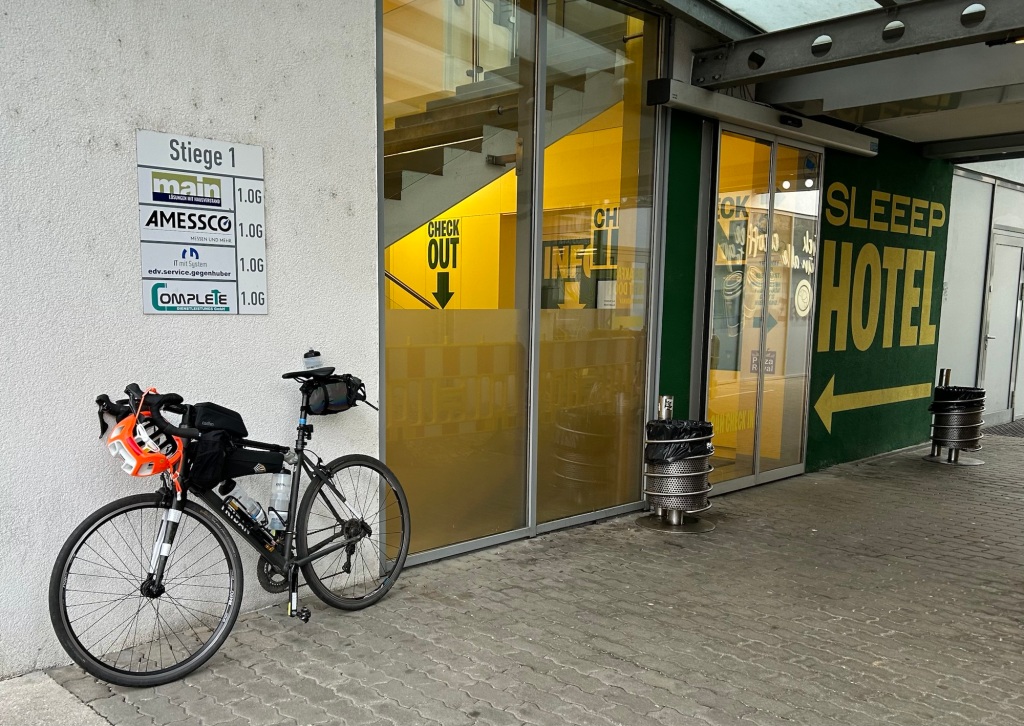
My steed chomping at the bit.
Saturday morning
After about 5 hours of pretty decent sleep for a motel, I had the champion’s breakfast of chocolate biscuits and Fanta. Energised, I rode to the school which served as the organiser’s temporary headquarters, grabbed my brevet card and banana, and got ready for my 8 am start.
The atmosphere was electric, with about 100 participants registered, many of them new, including me. Quite a few people were treating the brevet as a race – 200km is pretty short in the randonneuring world. Carbon frames, deep carbon wheels, aero bars, and a small frame bag was the typical setup. I felt like more of a traditional randonneur with my Triban, complete with dynamo and lights, frame bag, top tube bag, large saddle bag and four 1 litre bottle holders (two behind the saddle).
Intentionally overloaded in spite of the nice weather and civilised routing, my aim was simple – test my kit for my planned 2500km ultraendurance race in June – Race Across France (more details later). I’ve also registered for the 300, 400 and 600km brevets over the next few months – during these, I will keep on testing and refining all of my kit.
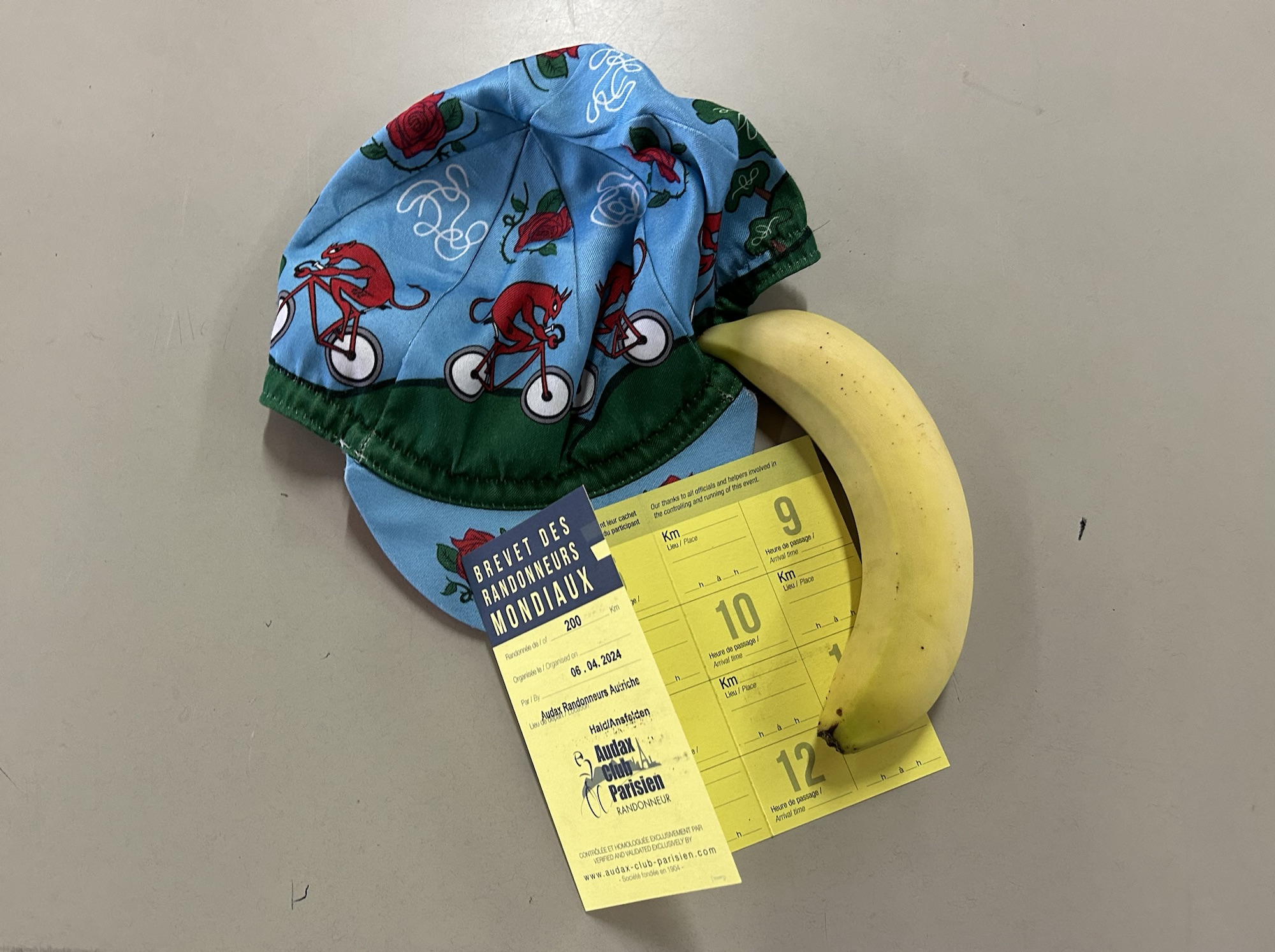
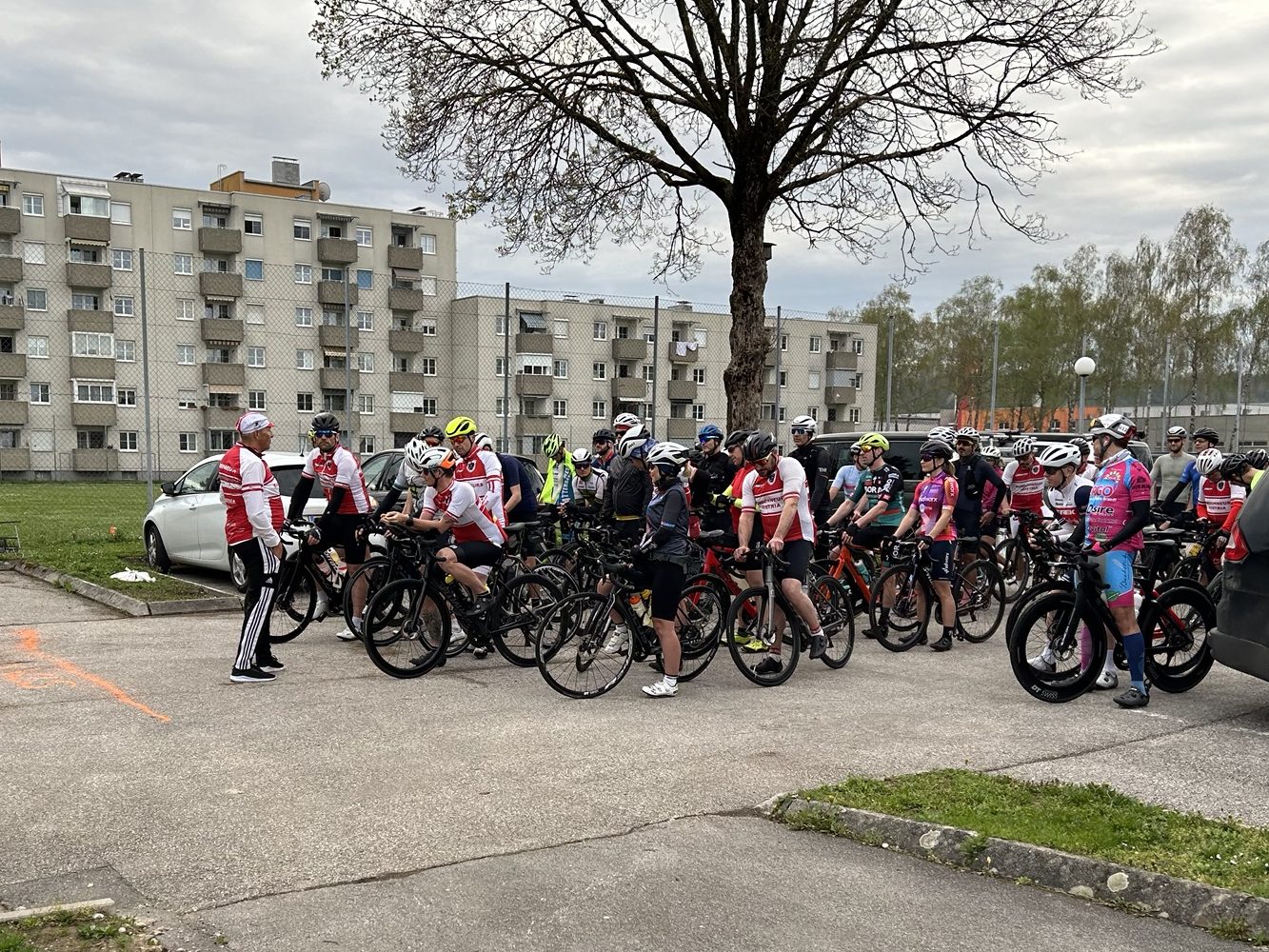
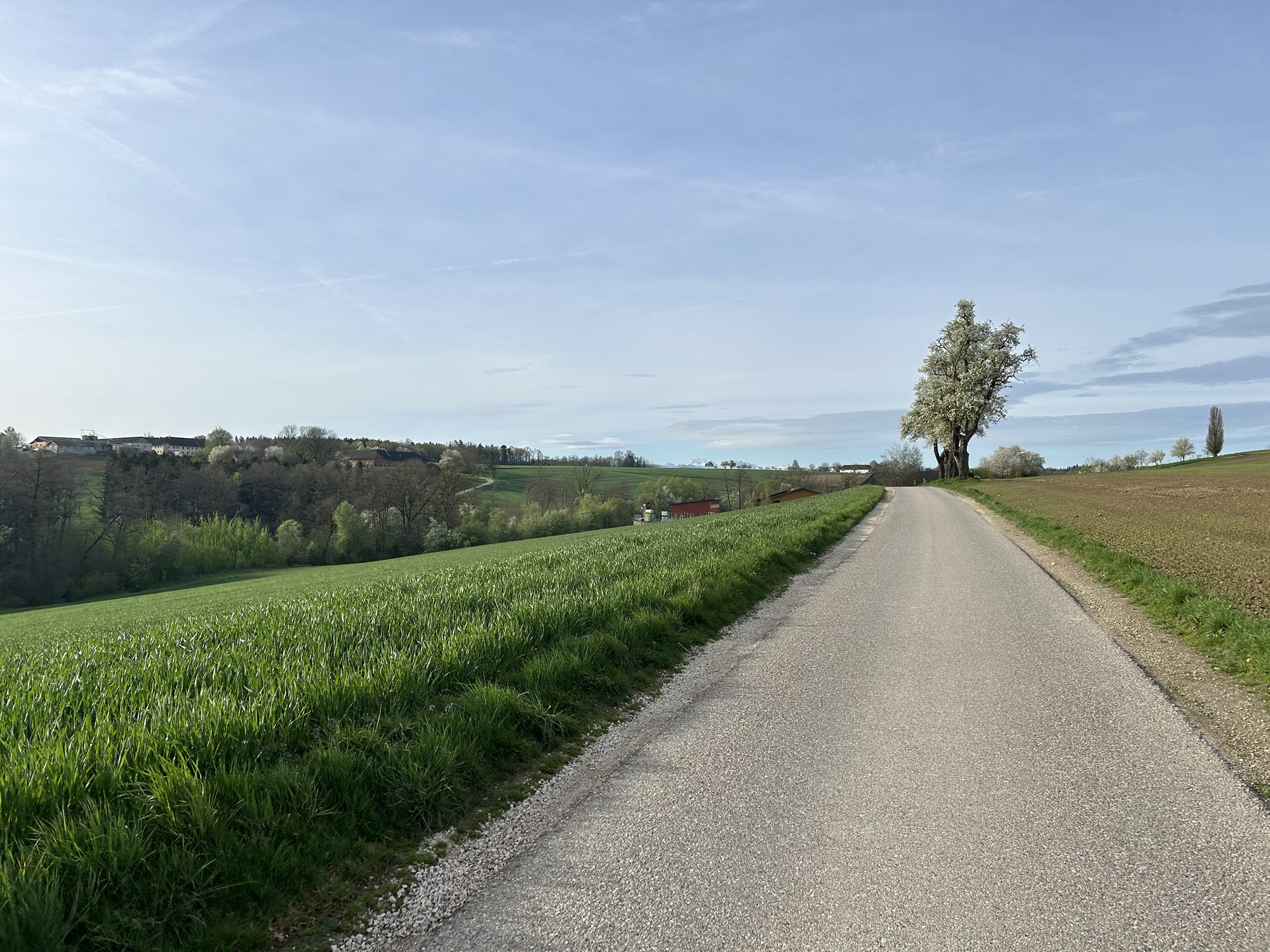
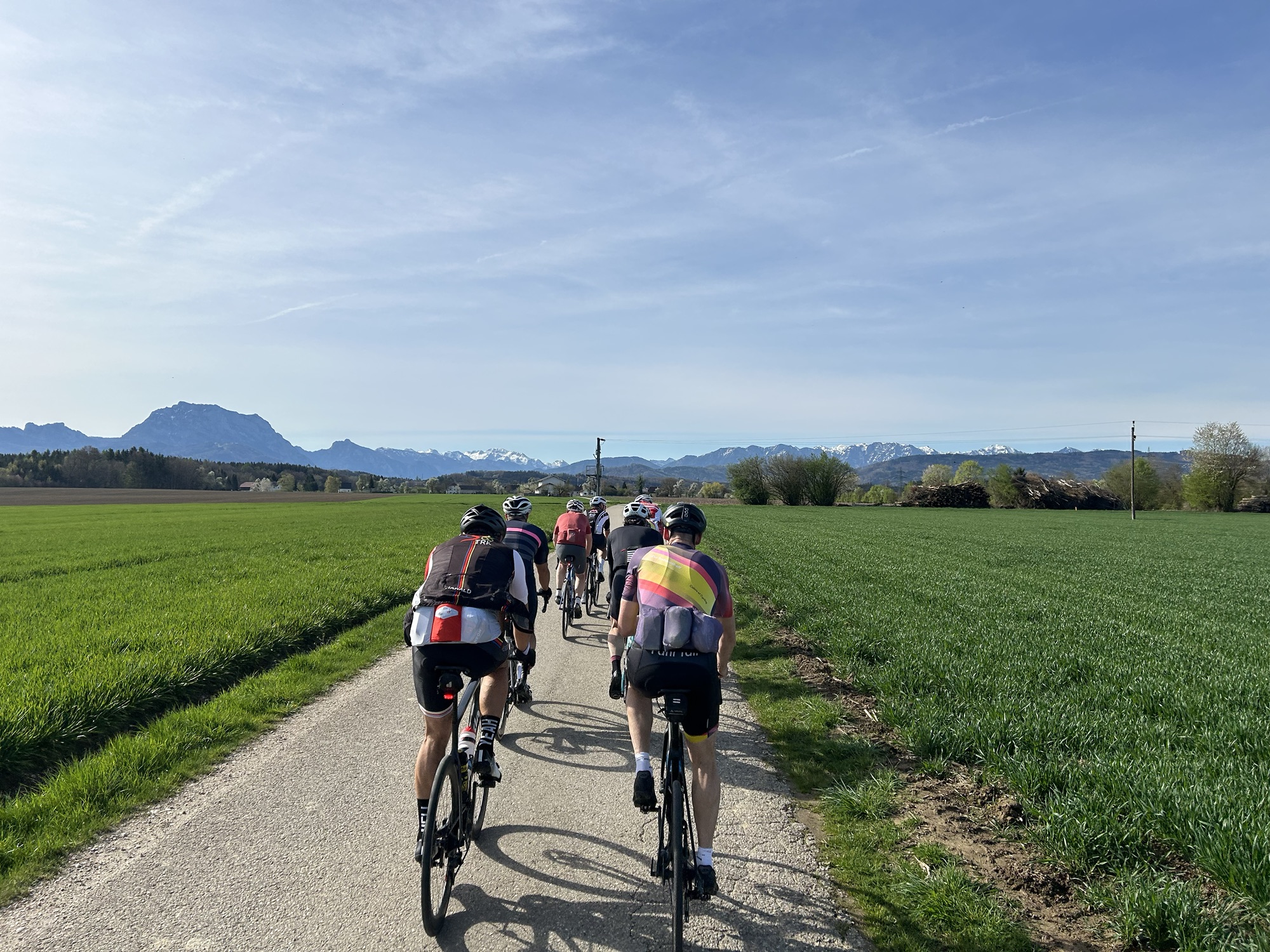
(L-R) My favourite casquette, my brevet card and starter’s banana; group announcement before the start; country lanes; in the group, with mountains in the distance
I set off with the 8.00 am group, but stopped after a few metres to help Martin with a mechanical. He turned back, and I continued alone. I caught up a few stragglers, but eventually 10 riders from the 8.15 group overtook me and welcomed me onboard with a cheerful “someone call a taxi?”. Cyclists are awesome people.
It was a gorgeous day, and I quickly look off my arm warmers. The route involved quiet back roads, but car drivers were quite aggressive, on one occasion deliberately aiming to ram the group off the road. I kept my distance and my emotions in check. The landscape was magnificent, and a spotted a white rabbit in a garden I passed, as well as countless pheasants in the fields.
The lead up to the first climb brought into sight an incredible view of snow capped mountains, and the road took us up through a wonderful pine forest. This was my first challenge – keep my power low. I have a good top end power, but this isn’t sustainable over many days. I therefore kept the pedals turning to keep me between 300-320W. It took some hard work, but I managed. The descent was fast, offering tantalising glimpses of the Attersee lake.
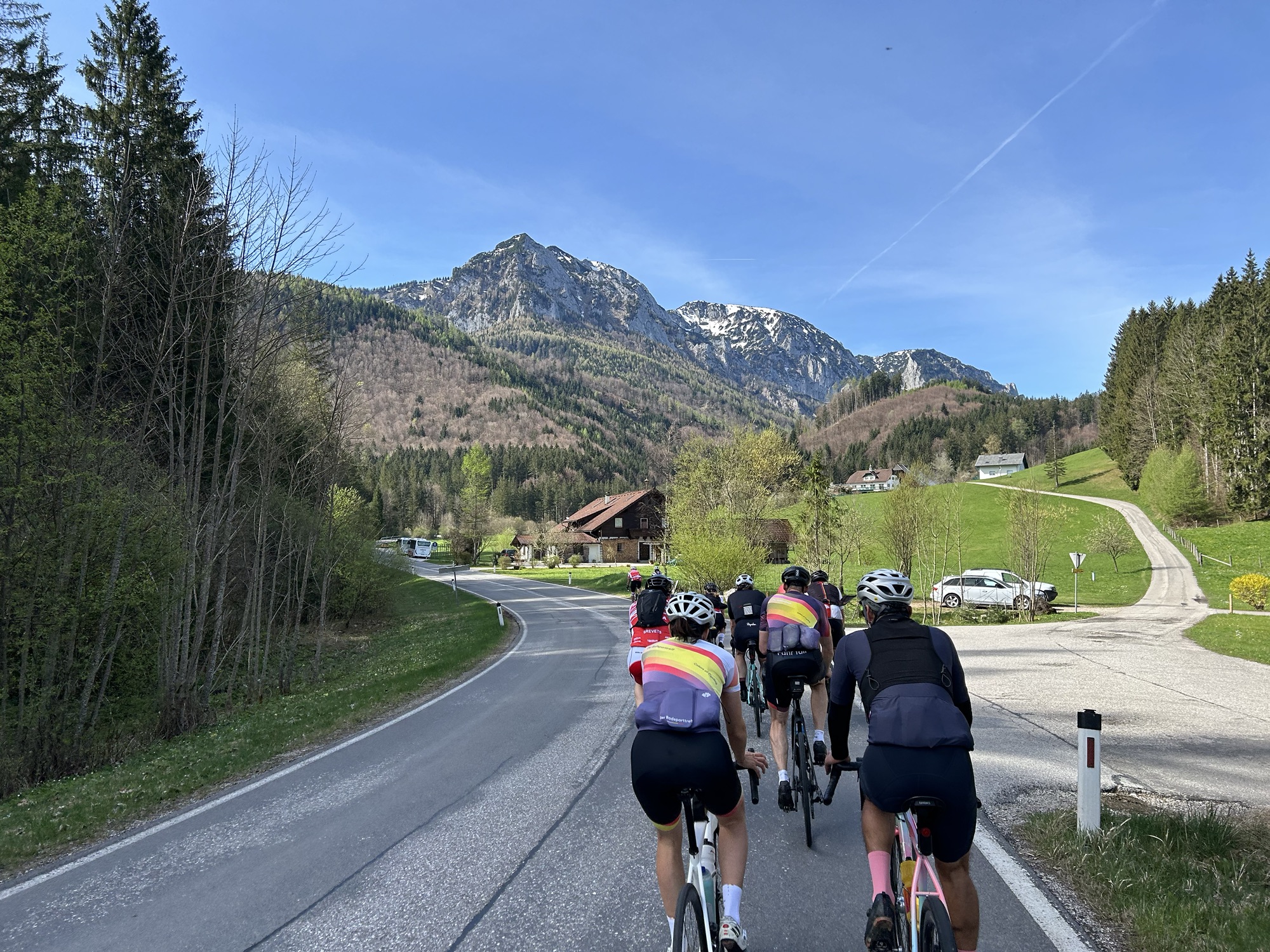
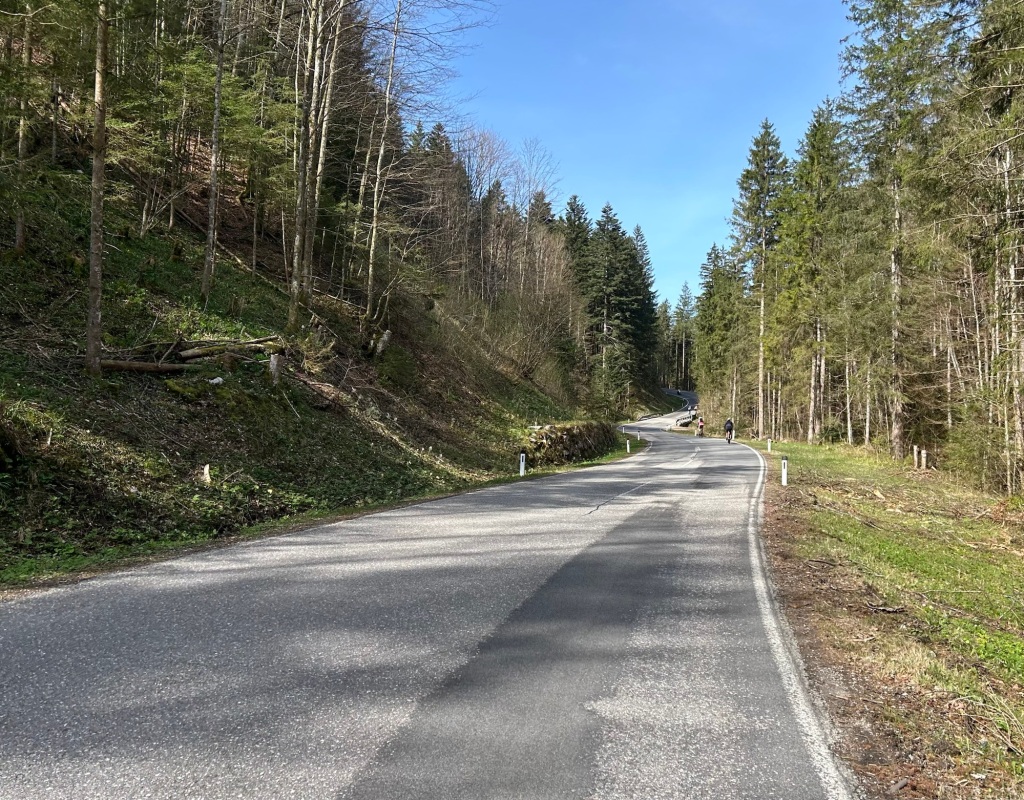
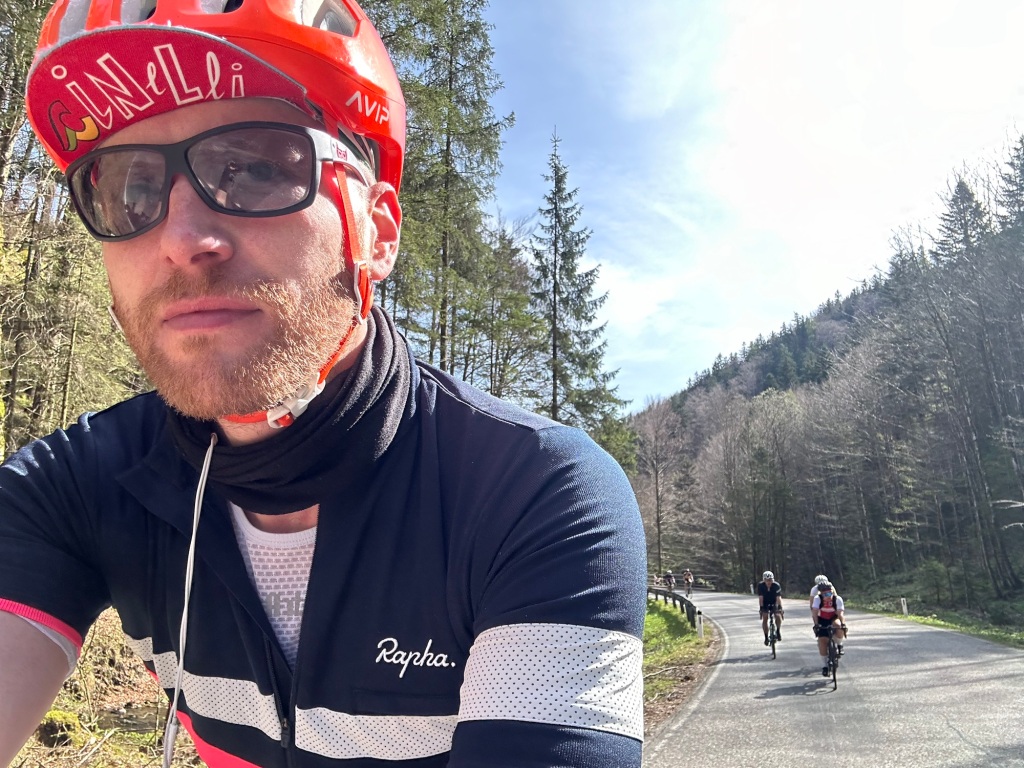
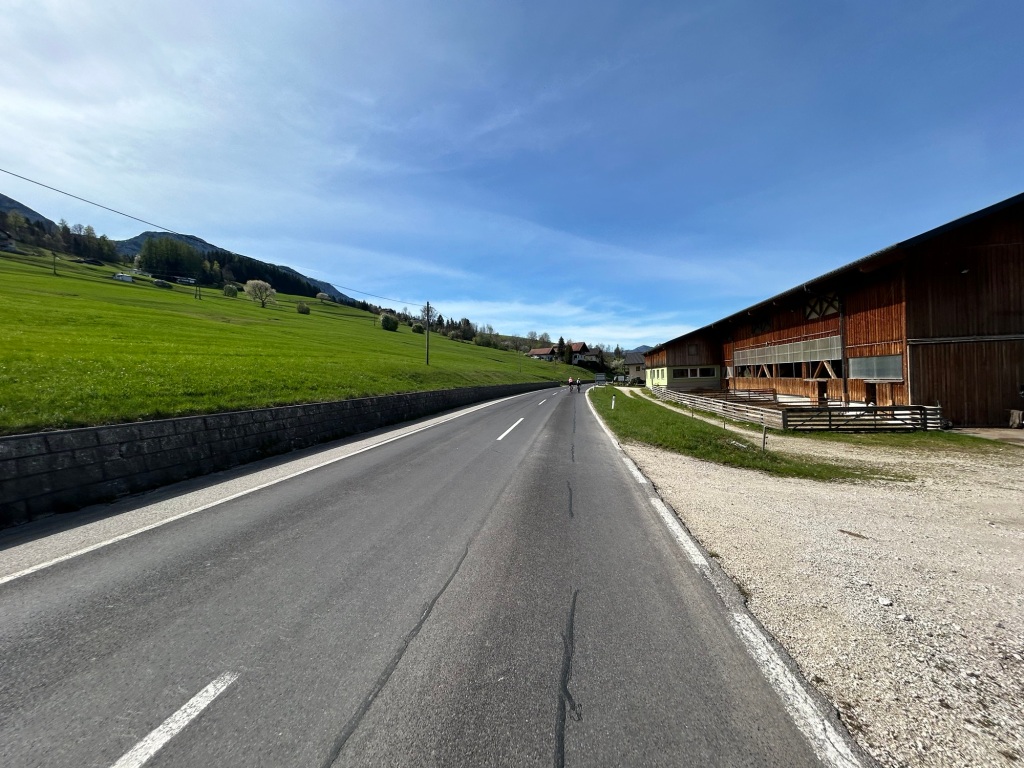

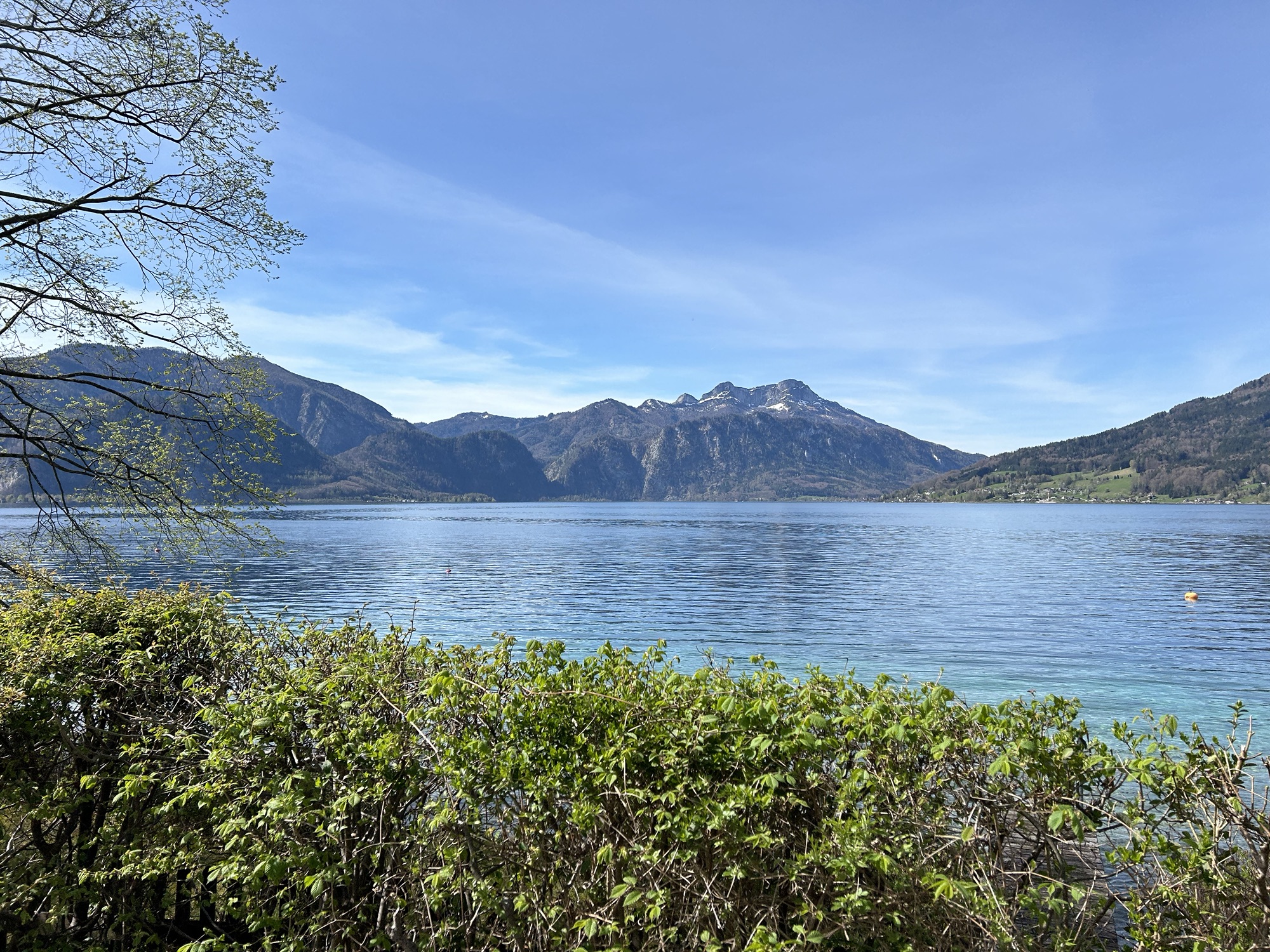
(L-R) Mountains getting closer; up the first climb; selfie on the climb; smooth downhill; group on the Attersee; view over the Attersee
After stopping for a long convoy of elderly motorbike riders to roll past, we set off around the lake, enjoying the cool, fish-scented air, interspersed with sights of scuba divers clambering in and out of the lake. I gradually lost the group, who seemed to pull away after leaving Attersee towards the neighbouring Mondsee, but I didn’t want to burn any matches to stay with them – my plan was to train myself to ride alone, not cruise in a group, or be able to ease boredom by chatting to others. I need to train solo for France.
I was surprised to find myself in my dark place after around 100km, which may have been due to this being my longest ride of the year, and the surprisingly hot weather for April (average 24C up to 33C) whilst riding in my Rapha merino wool top. I took a quick 5 minute break after 4 hours of riding, opening up my bag of Haribo – the nuclear option.
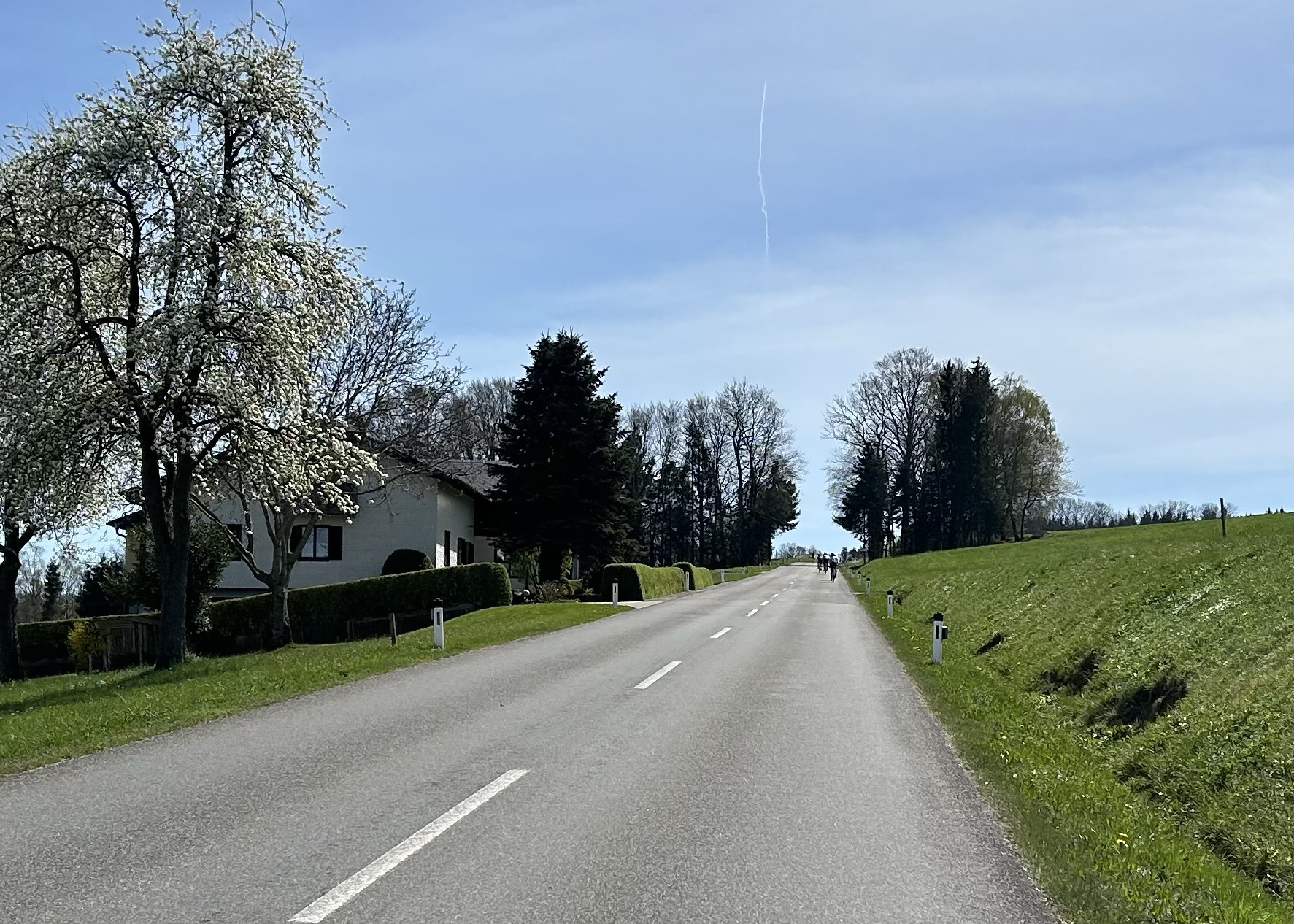
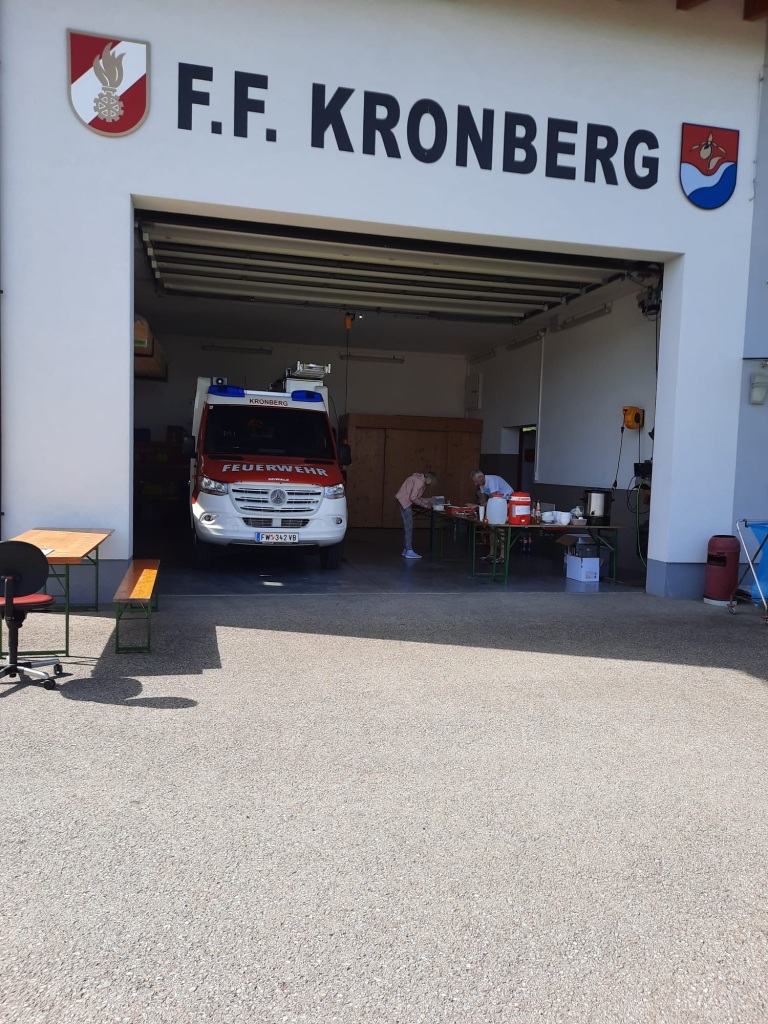
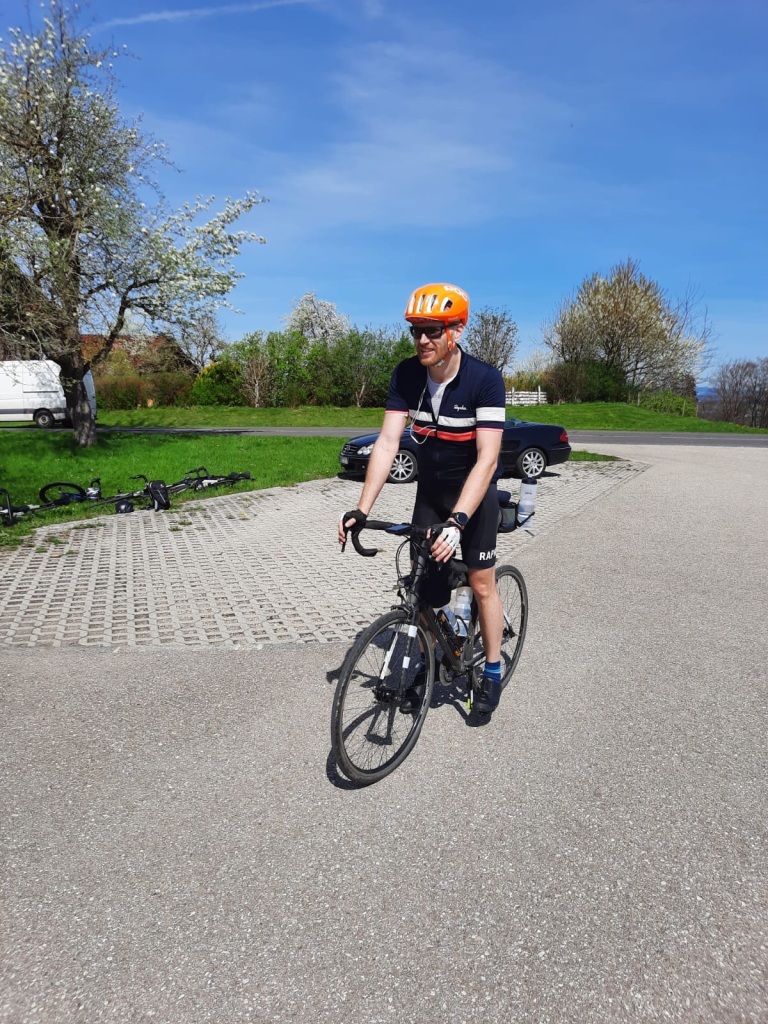
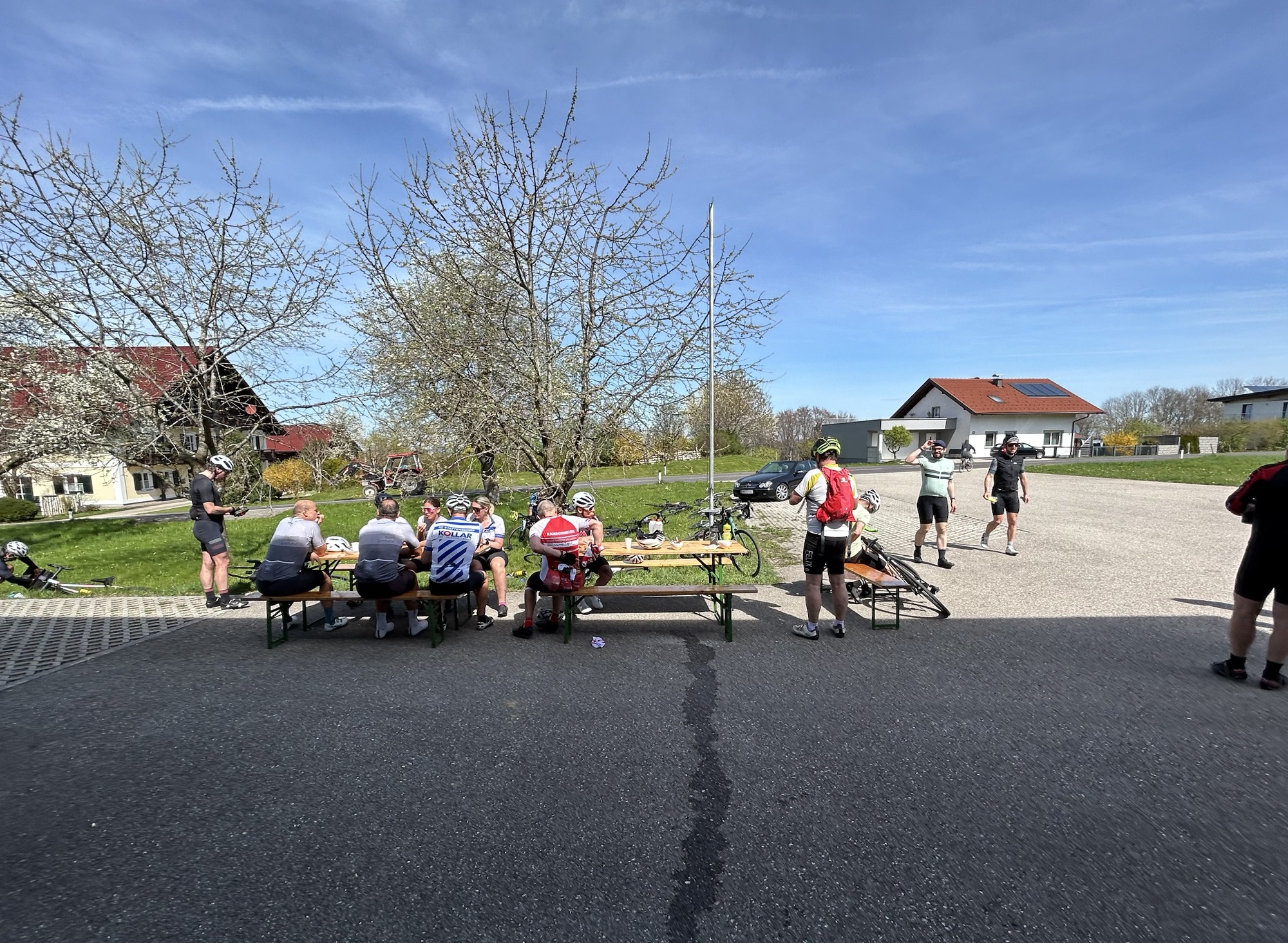
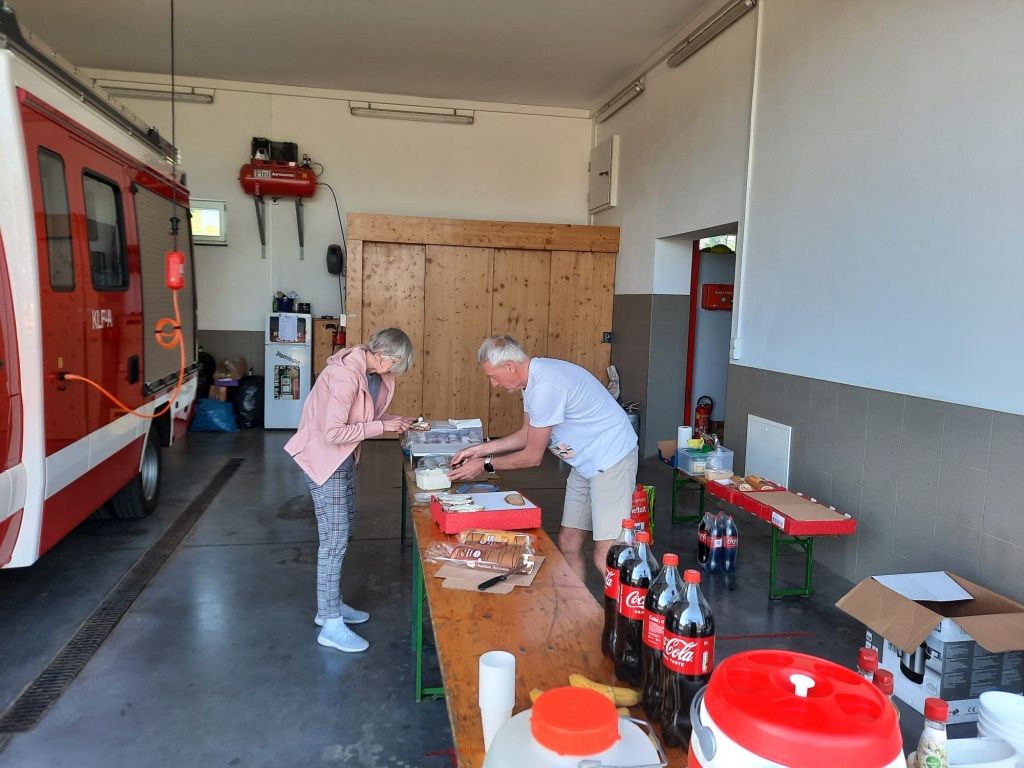
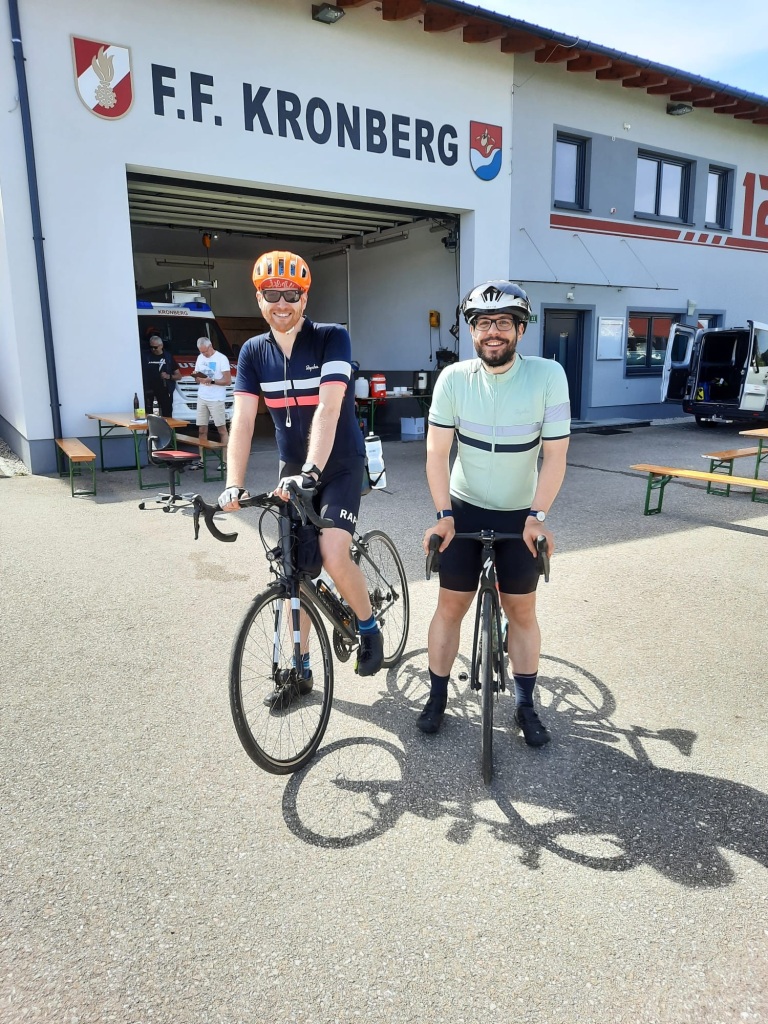
(L-R) Slow ascent in the sun to checkpoint 1; checkpoint 1 at the local fire brigade*; my arrival*; a cheerful atmosphere in the sun; the kind organisers preparing food and drinks*; our depart* (* = credit Randonneurs Austria)
Saturday afternoon
A long slow climb later, and I made it to the first checkpoint (118km in). There I met Martin and spotted the group I lost at Mondsee. My pacing wasn’t that bad. After getting my stamp and a bowl of soup, Martin and I left together.
We pushed on down a wonderful descent with views of Attersee again, then continuing around the beautiful crystal clear lake. It was a real pleasure, as I have only before seen it at high speeds during KOTL in 2021 and 2023, and never got to take photos whilst riding.
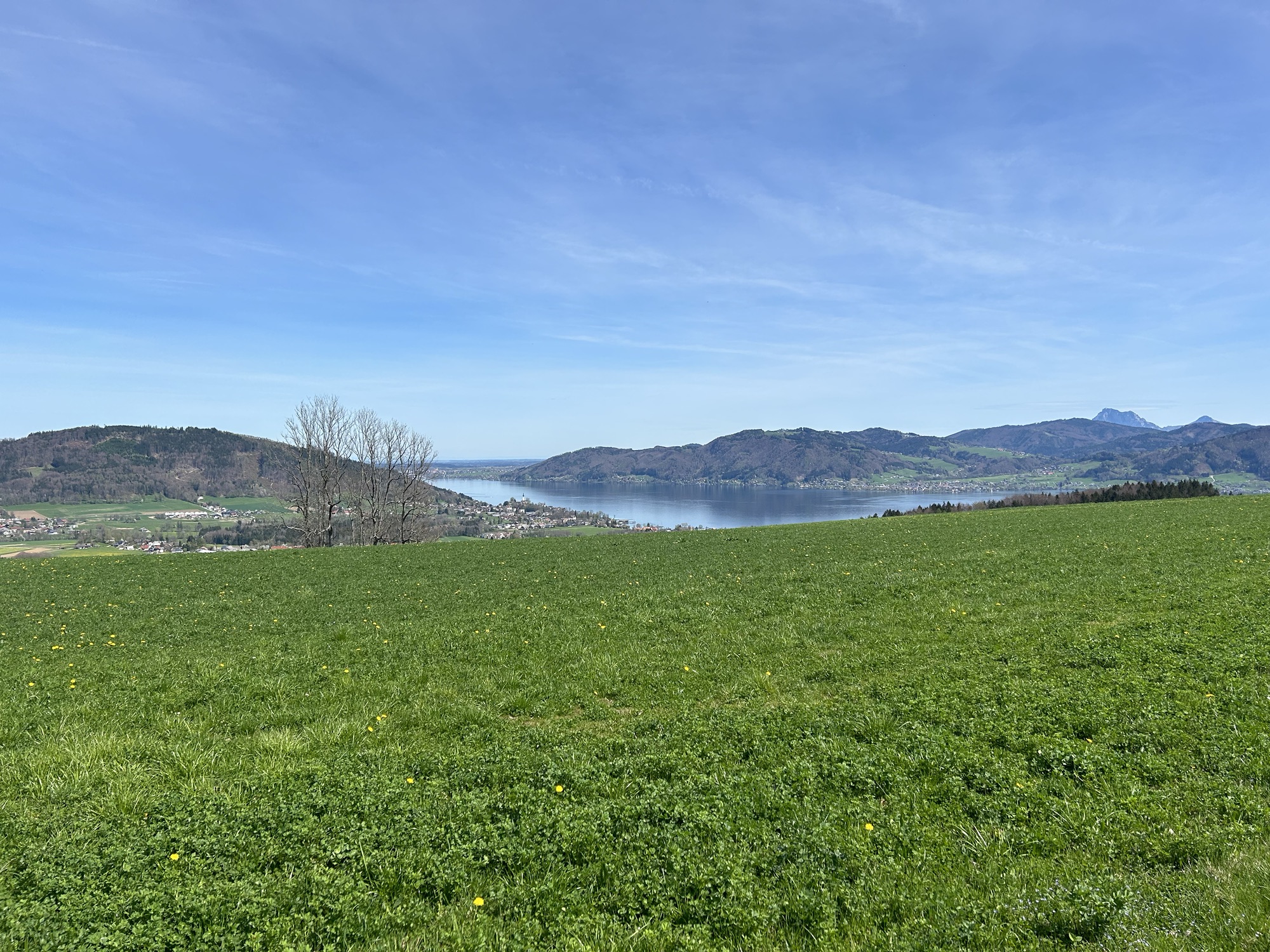
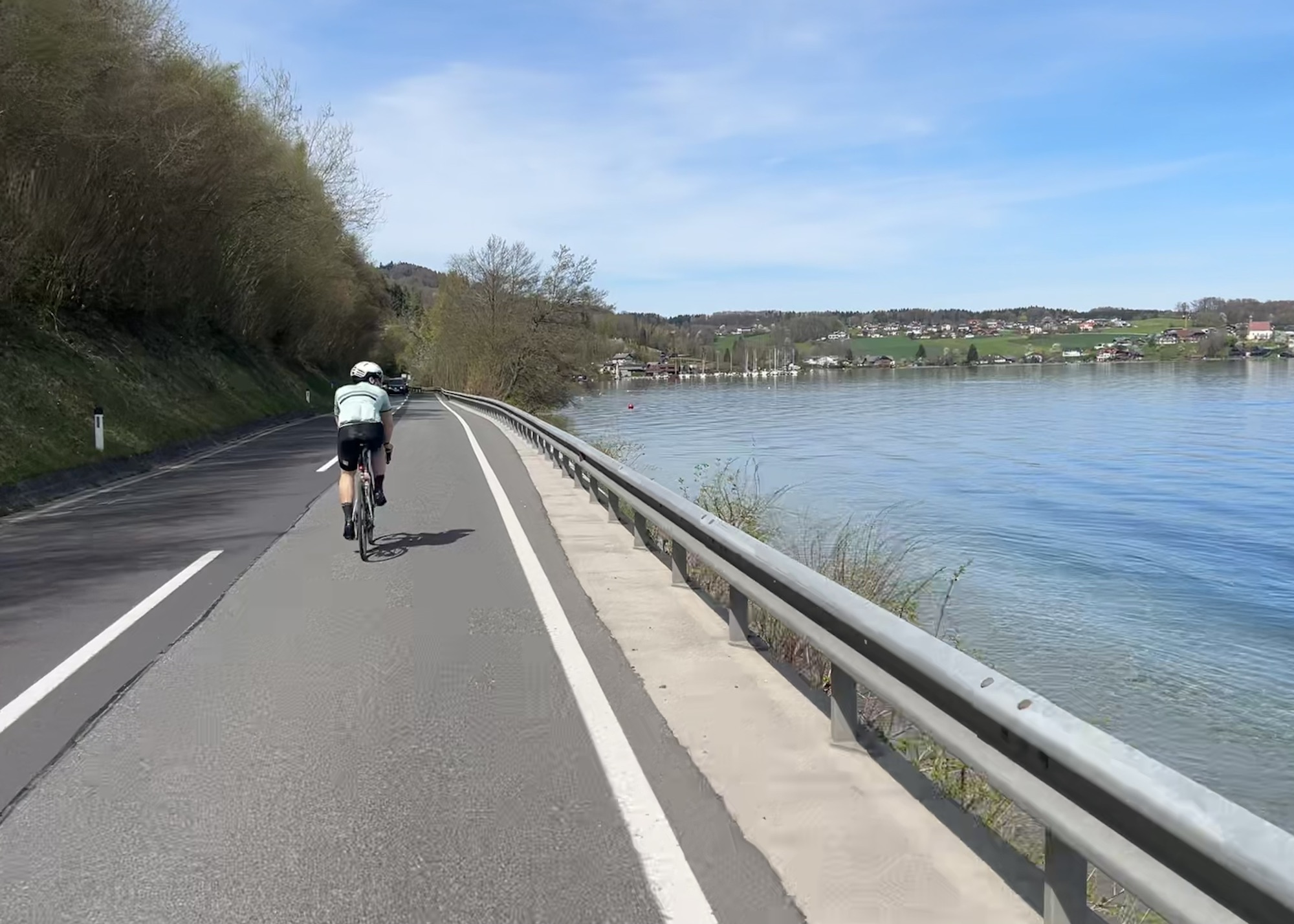
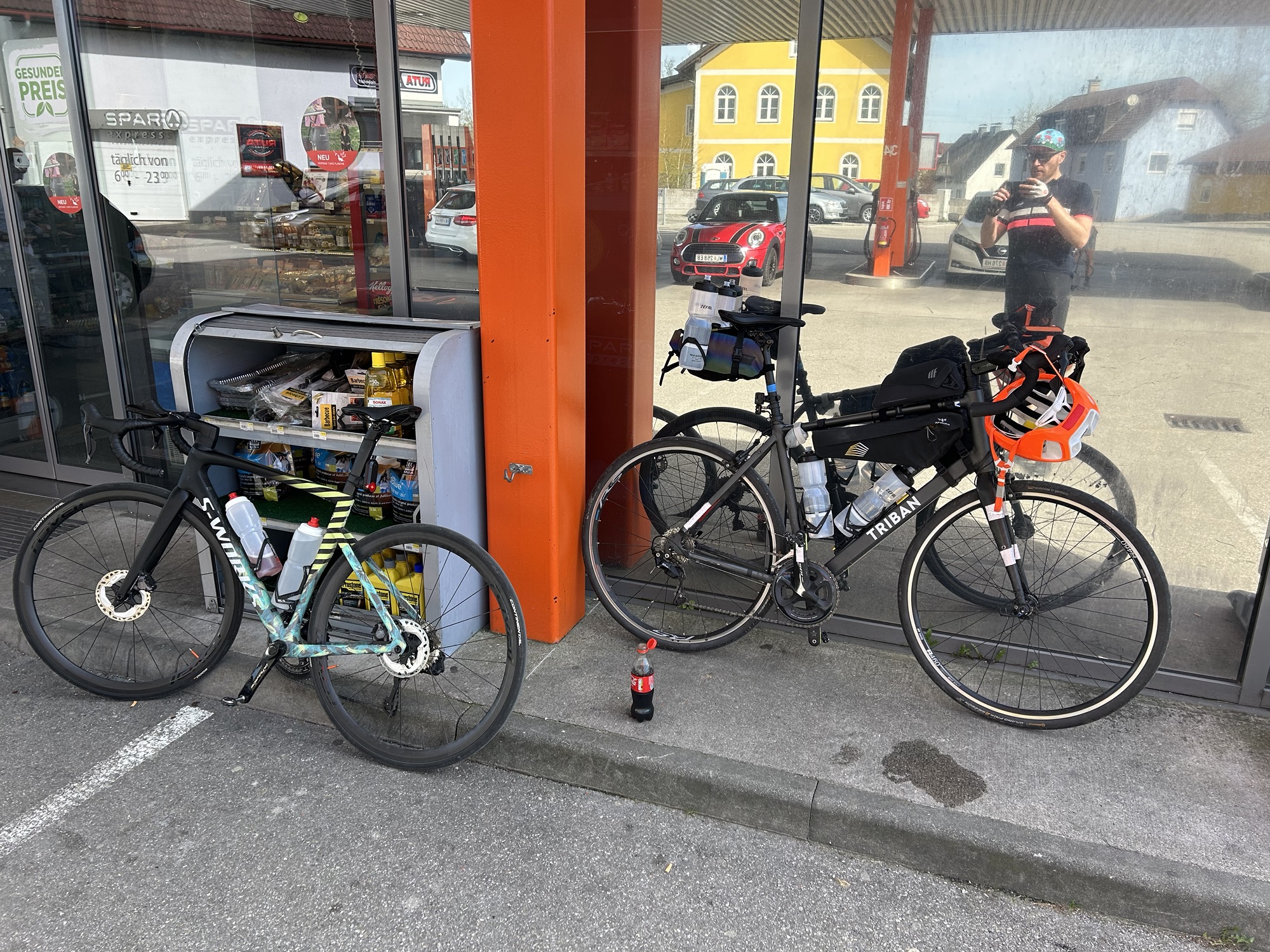
(L-R) View over Attersee; riding northwards around Attersee; checkpoint 2
From Attersee it was just another 70km – again, misleadingly short. I’ve been here at BMB before. The only way is to mentally isolate yourself from your target – keep riding at the same pace, and just be present in the moment. Counting down the distance or time will just make things worse. I wanted to chat with Martin, but I was still in my dark place, head down and keeping the wheels turning.
And that’s how we found ourselves at checkpoint 2 with 40km to go. Keep pedalling, things will improve. I took heart in spotting my Virtual Partner on my Garmin, set to a target time of 9 hours, was lagging behind me. Slowcoach.
My legs started to cramp when riding, but I found a way to keep pedalling without stopping. We played leapfrog with another rider as we had to stop for another mechanical of Martin, and eventually it was 15km to go. 10km. 5km. Ticking down, bizarrely enough I had to fight the strong urge to get off and take a break. Riding with Martin helped immensely, and I’ll admit I did ride in his slipstream more than I had hoped, but riding side-by-side was just too sketchy.
One last corner and we made it. The obligatory finishers photos were taken, and then we went inside to get the brevet cards stamped and verified. I struggled to eat a delicious bowl of spaghetti bolognese, but just sitting down was heaven. 200km done – the wee one. I got my certificate, my brevet card and my medal from the Audax Club Parisien.
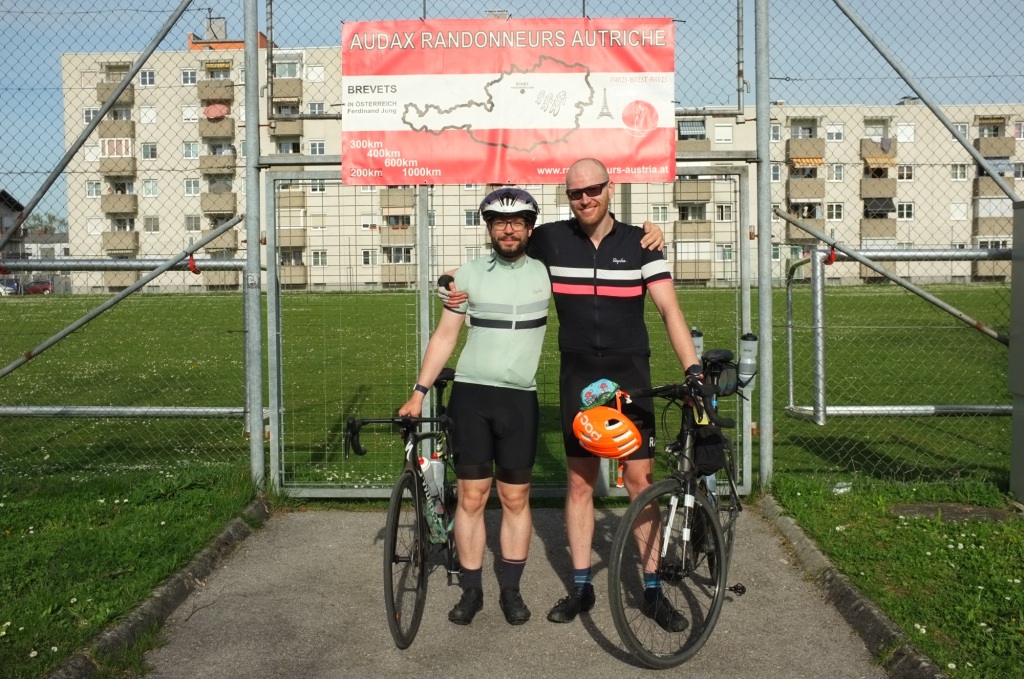
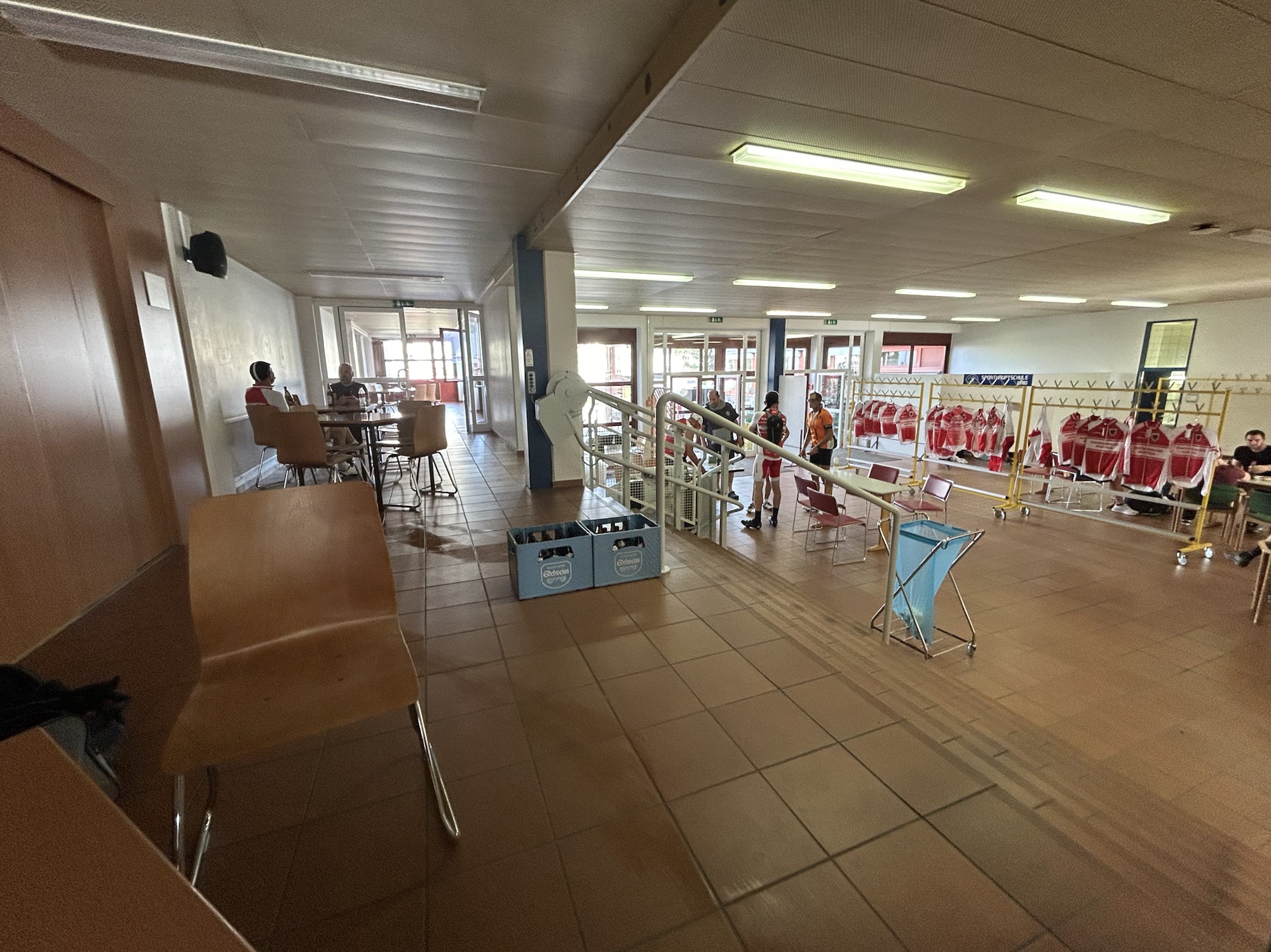
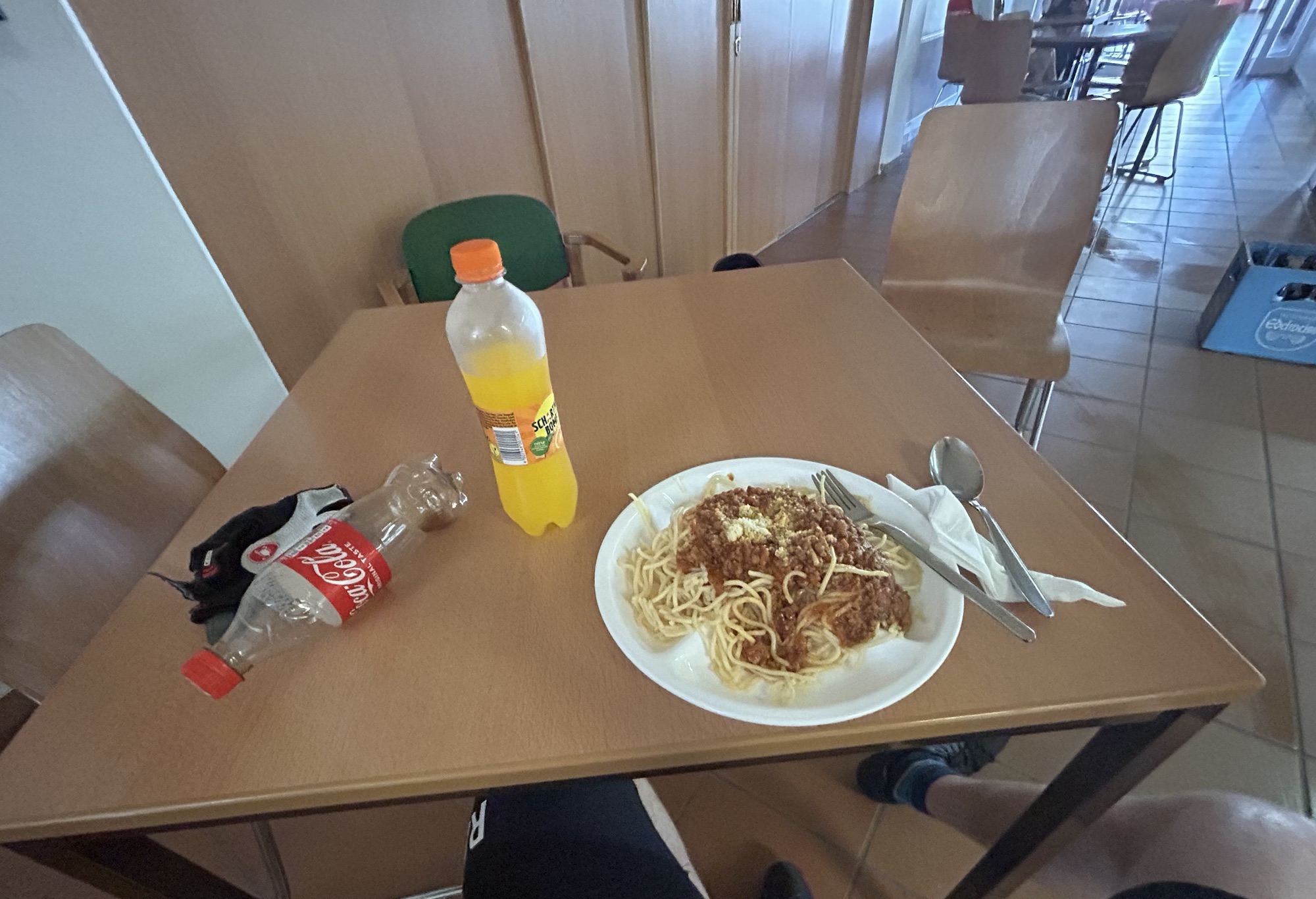
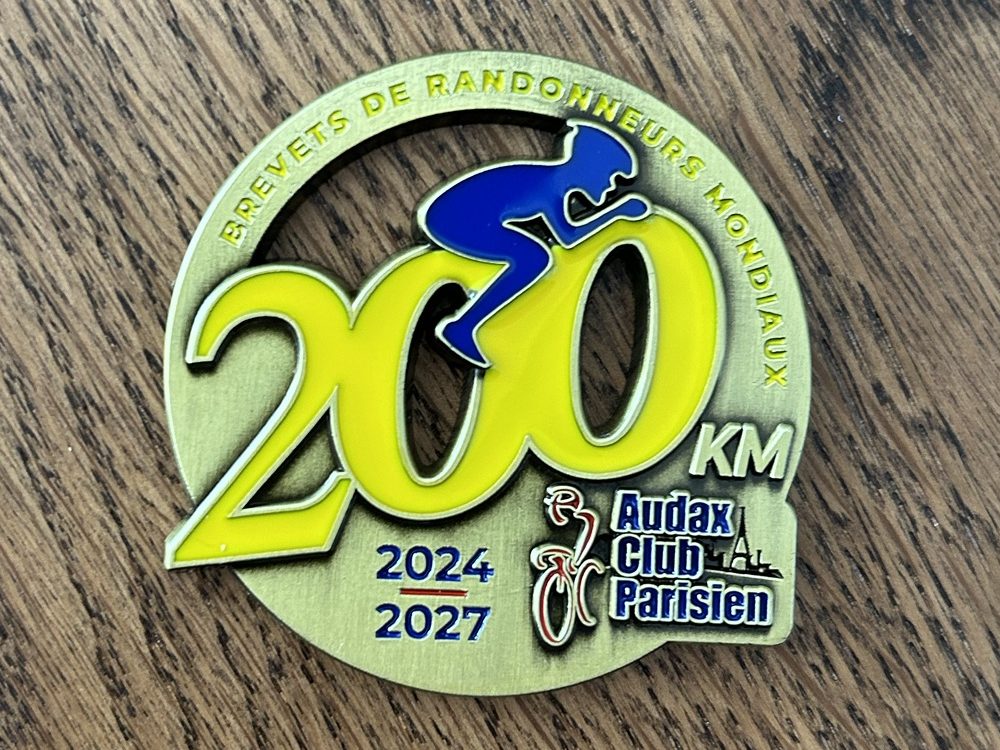
(L-R) The obligatory finishers photo with Martin and myself (credit Randonneurs Austria); the school HQ; a late lunch of tasty spaghetti bolognese; the finishers medal
My time: 8 hours, 52 minutes – my Garmin however pegged me at 7 hours 36, which meant about 80 minutes of not riding. I made it under my 9 hour deadline, so that even despite the difficulties I had putting out the power in the second half I could still make about 25km/h average on varied terrain. The faff time could be improved.
I will confess, there were several moments during the ride where I cursed myself for being so stupid and committing myself to ride Race Across France. 2500km is insane. 200km is less than a 10th of the distance, and I will be climbing mountain passes. My body was aching, and my legs did cramp.
But you know what. One day later, I feel pretty good, albeit with stiff legs, and am already planning on improvements for the 300km in one month. I can do it. Maybe I can really do France.
A few days afterwards, I realised something else – after completing the 200km ride, I can now officially call myself a “randonneur”!
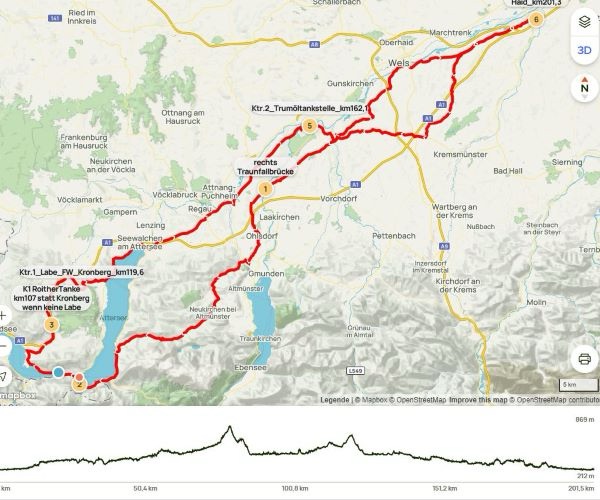
The route, running in a clockwise direction (credit to respective owners)
Reflecting on my kit
This one’s for the bikepacking nerds. I’m using the superrandonneur rides (200, 300, 400 and 600km) to prepare for my big 2500km ride in Summer. This 200km ride was my longest ride of the year, and really tested my legs and resolve. I made it though, and the Triban worked flawlessly.
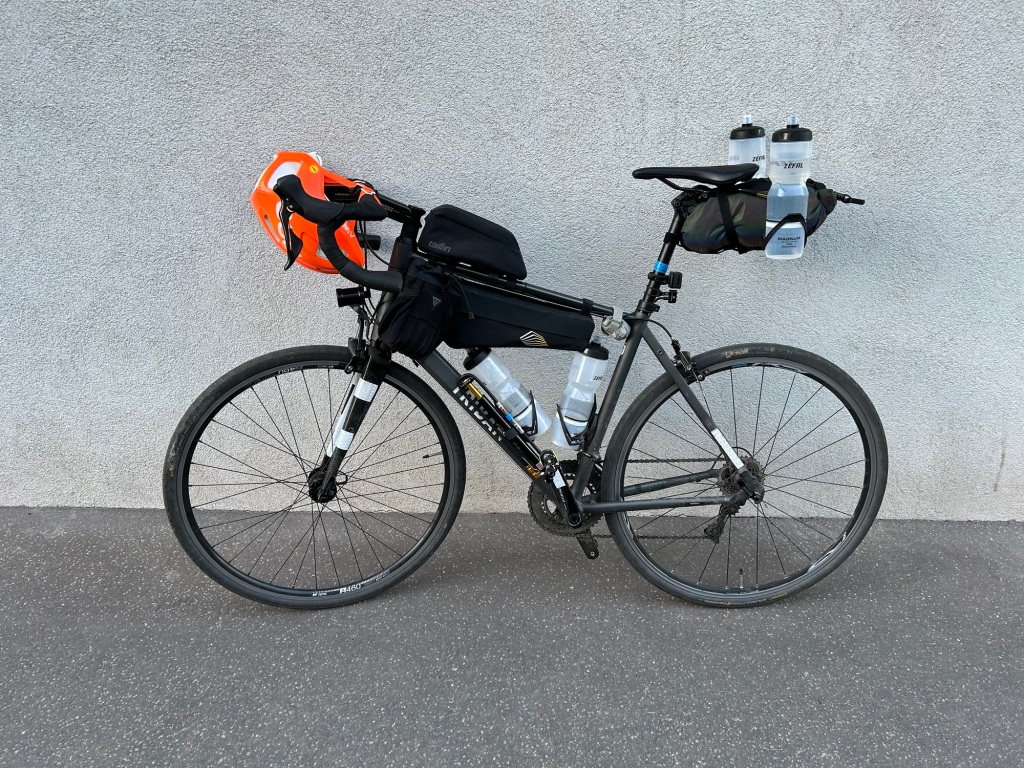
The setup for the 200km brevet – the basis for Race Across France
Triban – my trusty aluminium rim-brake bike. It’s my daily commuter with over 23,000km in 4 years, but over the last few months I have made some upgrades to make it especially comfortable. From BMB, I know that comfort is more important than speed – so I’ve added 32mm Continental GP 4 Seasons tyres, a suspension step and seatpost, Redshift handlebar inserts, and also a hub dynamo and lights. This way I should be completely independent from external power sources, letting me ride as long as my body and mind permits.
I also know the Triban thoroughly, having largely built it myself, can repair 99% of any mechanicals, and can easily source replacements parts from most local bike shops. I love it for its simplicity and reliability, and it can take quite a beating, such as riding on gravel – something I am cautious about with more expensive bikes. By riding it to work daily I can continually test it and make fine adjustments for comfort.
Bags – I’m using a Tailfin top tube bag which is simply epic, an Apidura framebag, a Topeak feeder bag, and a Restrap saddle bag. Clearly I’m not sponsored by any of them! The system worked well and offered enough space for spares, tools, lightweight clothes, and my food. I’ll probably add a second feeder bag for more options to eat on the bike. The Restrap saddle bag is good for shorter trips, but for Race Across France, I’ll definitely take the larger Apidura saddle bag.
Water – My strategy on riding with few stops depends on carrying sufficient water. I also don’t like being thirsty in the summer heat. There are plenty of options, such as hydration backpacks and bladders, but I like the idea of a saddle mounted bottle rack – nothing on my back and using practical bottles. On this ride, I tested a cheap Chinese wishbone rack also designed to prevent saddle bag sway. I also bought one from Topeak, but found this mount too unstable. The wishbone rack was good as a concept, and I actually preferred drinking from the bottles behind my saddle as opposed to those in my frame.
It was a pain to throw my leg over the saddle however, and the arms of the rack were too short, with the tops of the bottles stopping me from moving around the saddle when descending and when my taint became sensitive. I’ll have to think of some alternative approach.
Nutrition – After all the carb loading, I decided to keep on top of fuelling, following my Garmin’s alerts and eating half a muesli bar every 30 minutes. After 100km, my stomach was feeling quite sensitive, and I wasn’t sure if I was full or hungry. I didn’t bonk, but felt low on energy during the second half. I will certainly need to work on improving nutrition, but I suspect I will adjust to this on Race Across France depending on food available and how I feel.
Tech – Nothing special today, just my iPhone (which survived without charging) and my Garmin 1040 Solar. The Garmin is incredible – with a sunny day and 9 hours of riding I only used 30% of my battery. The dynamo and lights didn’t get much usage today, but from my commuting efforts, they are epic.
Thanks to Ferdinand Jung and his team for the great organisation and support!
Find the official brevet report here.
Here’s the official website for Randonneurs Austria.
I’m keen to learn about how to become a better ultraendurance rider, and am reading quite a few articles and listening to podcasts from other riders. Nevertheless, I’d love to hear any tips from you, dear reader! Do you have any suggestions on how to prepare or improve my performance?
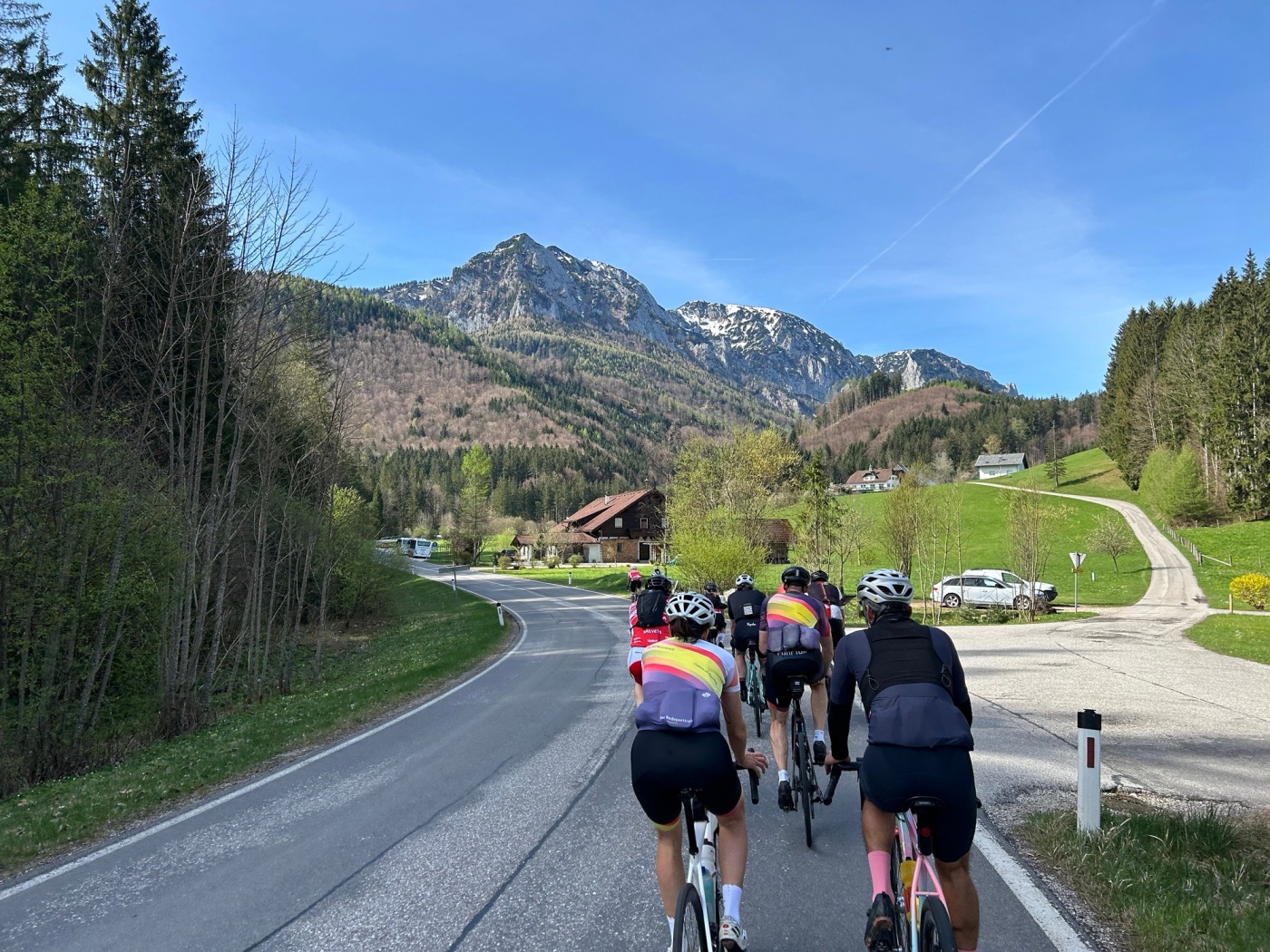
Gratulation zum 1. Brevet!
Ich bin vom 200er bis zum 600er auch alle in Haid gefahren, aber Tipps geben?
Nicht mitreissen lassen von den schnellen, sonst ist der Mann mit dem Hammer gleich neben dir…
Hier 7 gute Tipps:
https://bikepacking.com/news/paul-de-vivie-has-been-there-video/
LikeLike
Vielen Dank! Ja, die ganz schnelle haben es um die 6 Stunden geschafft, wäre aber nicht mein Ziel. Ich schaue mir gerne das Video an!
LikeLiked by 1 person